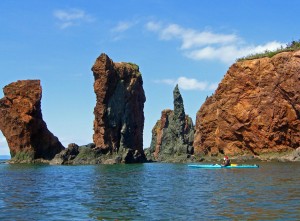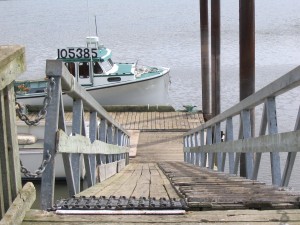




 If you are a first time traveller to Canada or to the Canadian Maritime provinces, you will no doubt want to know the “pertinent facts”:
If you are a first time traveller to Canada or to the Canadian Maritime provinces, you will no doubt want to know the “pertinent facts”:
Weather in Nova Scotia: Nova Scotia is one of the smallest provinces in Canada and is located east of Maine, USA. The entire province is situated close to sea level and no matter where you are in the province, you are always within 35 miles of the shoreline! As such, the climate is quite moderate, being influenced greatly by the nearby ocean. This means that the temperatures are less extreme both in summer and in winter than in other parts of Canada. Summertime high temperatures are typically between 20 and 25 degrees Celsius (a comfortable 70 to 85 degrees F), and the evenings are perfect for stargazing and sitting by the fire. Spring and fall daytime highs fall around 15 degrees Celsius, with autumn offering clear, sunny skies, a brilliant display of foliage and spectacular sunsets. Evenings tend to be cooler, typically about 5 degrees Celsius though by mid October there is typically an overnight frost.
Weather forecasts for nearby communities are as follows, though the mountains on either side of us shelter us from many a shower, even if it is forecast for these communities:
http://www.weatheroffice.gc.ca/city/pages/ns-7_metric_e.html
http://www.weatheroffice.gc.ca/city/pages/ns-13_metric_e.html
To convert to Fahrenheit:
A quick and FAIRLY accurate way to convert temperatures is to take two degrees off the Celsius temperature, then double that number and add 32 (which is the temperature water freezes at in the Fahrenheit system whereas in Celsius measurement, water freezes at zero). So 20 degrees celsius, becomes 18, multiplied by 2 is 36, add 32 equals 68 degrees Fahrenheit. Mathematically speaking, the formula would be 2(Co-2)+32. OR…for a conversion method that is easier on the brain, try…
http://www.theweathernetwork.com/conversions/cans0106
http://www.globalsurfers.com/country_details.cfm?land=Canada
 Exchange Rates: http://www.xe.com/
Exchange Rates: http://www.xe.com/
Canadian currency is very similar to American currency–one hundred cents to one dollar–but bills of different value come in different colors; perhaps the most notable difference for those used to American currency is that to save costs in wear and tear of the bills, the Canadian government converted the $1 bill into a gold colored coin with a picture of a loon on it; hence, it was dubbed the “Loonie”. Shortly thereafter, the $2 bill was converted into a coin, which hitherto became known as a “toonie” (think, “two-nie”). While coin collectors may have in their possession a 50 cent piece, they rarely surface in circulation. As values are calculated as parts of a whole of 100 cents, Canadian values are written as $0.25 (twenty five cents, or .25 of a whole dollor) or, for example, $3.15 (three dollars and 15 cents, that is, .15 of a whole dollar).
Distance: Distances are measured in kilometers in Canada rather than in miles. One handy trick to make this easy to understand is to think in terms of time when travelling greater distances. For example, 100 km is about 1 hour of highway driving (if you average speeds of 60 miles in a 60 minute hour, or 60 mph)… Calculated in metric distance, you can easily estimate your travel time by moving the decimal over two spaces to the left…so 250 km could be estimated to be about 2.5 hours of travel time (or 2.5 X 60 miles…or about 150 miles). You can also reverse the process to convert miles into time, simply by thinking that we go about a mile a minute on the highway, so 180 miles would be 180 minutes (or 3 hours). Lastly, fine tune your estimate with your awareness that if you drive a little faster than 100 km/hr (60 mph) you’ll arrive a little sooner. Or if you are taking your time and enjoying the scenery, add a little time to your estimate. With a little practice, you’ll be estimating your arrival times with ease!
If you are used to the American system of calculating distances, you may prefer to simply multiply the posted number of kilometers to your destination by 0.6 in order to determine the number of miles of travel. This is especially effective for shorter distances …so 6 km would be about 3.6 miles (6 X 0.6). Or 2 km would be about 1.2 miles (2 X 0.6). It won’t take long before understanding distance measurement won’t be challenging at all !
!
Language: Nova Scotia’s official language is English though there is a significant population of Nova Scotians that claim French as their first language. For the most part, though, people in the service industry will speak at least a little of both languages OR they will do their best to communicate with you. Should you speak English only and you encounter someone who speaks French only, a smile and a genuine attempt to greet them with “Bonjour” will take you a long way to gaining their willingness to do their best to help you out, even if it is through gesture and pictures!! People are just people, and if you know someone that has travelled to Nova Scotia, you will have no doubt heard of the incredible friendliness and helpfulness of the people in this beautiful province…and of that one special Nova Scotian that went above and beyond to help them out!!